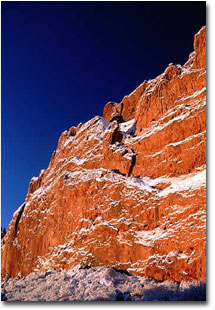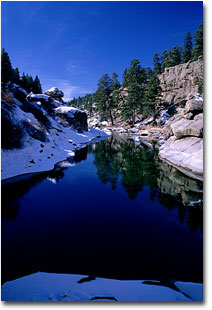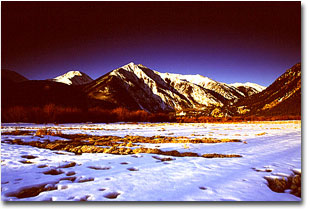
|

Feature Article...
Six Steps to Better Winter Photography
Text and Photography Copyright James Egbert
All rights reserved.
 The ground hog came out and said spring is upon us. The calendar
on the wall states that spring has officially arrived, but here in
Colorado, all that seems like a fairy tale or funny joke...Colorado
tends to change seasons in it's own sweet time. So to say
it's time to get out and shoot winter scenes in April may seem a bit odd
to the out-of-towner, to those nature photographers who have endured a few
"Colorado" seasons, we know that Old Man Winter is still alive and well.
The ground hog came out and said spring is upon us. The calendar
on the wall states that spring has officially arrived, but here in
Colorado, all that seems like a fairy tale or funny joke...Colorado
tends to change seasons in it's own sweet time. So to say
it's time to get out and shoot winter scenes in April may seem a bit odd
to the out-of-towner, to those nature photographers who have endured a few
"Colorado" seasons, we know that Old Man Winter is still alive and well.
The thought of going out to shoot winter scenes in January seems a bit too rugged for me.
I would rather be at home next to a warm fire, sipping hot
cocoa and watching the weather channel showing the warm weather in Tahiti. Instead, I
wait until mid-March & early April to get out my snow shoes. When all
those spring-breakers are heading to Ft. Lauderdale or Miami, I'm
heading up to the high country.
Two hours west of Colorado Springs are some of the most beautiful winter
scenes I have ever witnessed. Just outside Buena Vista are located San Isabel National Forest,
Sawatch Range, Sangre De Cristo Range and Pike National Forest, places where
you can witness the most photogenic mountains that rise over 14,000 feet above sea level. On a clear day, when the air is clean and crisp,
elk and mule deer can be seen venturing into the lower valleys in their search for food
Some the large snow fields in Colorado are beginning to melt at this time of year,
creating run-offs and photogenic cascades to the small creeks and rivers.
Most of the time, the skies are clear and the snow glistens like millions
of diamonds on a carpet of white. However, in the midst of this beauty lies the potential for
avalanches. As the warm spring sun starts to heat up
the snow, conditions become more favorable for these dangerous occurances. So learn the warning signs of a potential avalanche and be aware of the conditions along your intended route, taking extra caution when trekking away from the
main trails. Always be prepared with the extra water and supplies that may be needed
should you become stranded for a short period of time. I always recommend that a travel plan and a map
be left at home, detailing your routes and destinations.
Also give people an idea of when you're planning on returning and a time to
start looking for you if you don't report back on time.
While there are many excellent techniques and strategies for capturing winter scenes on film, here are a few
that work well for me -

- Early To Rise - Get up early and get to where you want to shoot before
the sun comes up. The best time of day for most scenes is early morning and late afternoon, when the
sun is burning through more of the earth's atmosphere, casting warm-colored hues on the
scene. This warm, dramatic lighting can add a mystic feel to the
image.
- Almost 3-D - Keep in mind that it's desireable to close the aperture to a
narrow opening of f/22 or f/32 in order to increase depth of field in the final image.
A good nature scene should have compositional balance, the foreground leading to
the main subject and through to the supporting background. Watch for distracting elements in your view
finder that would detract from your subject. Be very picky! Following
this guide will enhance the image to the point where you feel
like you can actually step into your printed image. Most importantly, use
the K.I.S.S. theory (Keep It Simple Stupid). Don't overload the
image with too much of the scene, keep the subject clear and the image uncluttered.
- In The Zone - I suggest that if you have a newer camera that is
equipped with zone or "matrix" metering, you should set the camera on
aperture priority and let the camera figure out the shutter speed to
balance the exposure with your selected f/stop setting. Alternatively, consider substitute metering, bracketing or
use of the "sunny-16 rule" to
arrive at the correct exposure in these tough-to-meter snowy winter scenes.Film selection is also important, my
preference is for slower speed slide films that provide fine grain and rich color.
Professional grade films enrich color
and provide the best saturation to create vivid images that just pop off
the paper.
- Lights, Action, Color - When photographing with color film, so be sure to have
something colorful in the image! Red willow bushes, clear blue skies, golden dried grass and old buildings
that are weather beaten but still retain some color are good examples. When set
against snow, colorful subjects will stand out better.
- Ignore The Weather Channel - While clear blue skies can add a crisp,
cool feeling to your image, many times it's more effective to have a
little bad weather to make a good photograph. No matter what your subject is, look for fog,
snow and steam to add depth and interest to your images. These situations
will more often than not produce dramatic images that convey the real
feeling of winter in Colorado. A typical exposure may require opening up by one half to a full stop, which will
help details pop up from any haze in the scene.

- Chasing The Sun - Regardless of the time of day, your position in
relation to the sun is important. The sun's position can drastically
change a landscape in a matter of minutes, especially at sunrise and
sunset. Follow the sun through a scene and watch for changes in light.
Many times it takes several shots to capture the right balance of
light, color and contrast in a scene. Also keep in mind the direction you point
the lens when shooting in bright sunlight. Details tend to get lost when you are shooting into the
the sun due to lens flare and ghosting. Metering is the most
important consideration in these situations as green pine trees can turn black and
snow can turn grey due to underexposure. Be sure you are versed in
your camera's metering system and can correctly compensate in these tough lighting conditions.
Shooting snow scenes is a challenge for any photographer no matter the
experience level, but persistence will pay off in the long run as you expand your knowledge and
fuel your desire to be creative in your photography. So get out there, be safe and be a part of winter
photography in Colorado.
Editor's Note - Be sure to visit James Egbert's web site to learn more about his Colorado workshops.
|

 The ground hog came out and said spring is upon us. The calendar
on the wall states that spring has officially arrived, but here in
Colorado, all that seems like a fairy tale or funny joke...Colorado
tends to change seasons in it's own sweet time. So to say
it's time to get out and shoot winter scenes in April may seem a bit odd
to the out-of-towner, to those nature photographers who have endured a few
"Colorado" seasons, we know that Old Man Winter is still alive and well.
The ground hog came out and said spring is upon us. The calendar
on the wall states that spring has officially arrived, but here in
Colorado, all that seems like a fairy tale or funny joke...Colorado
tends to change seasons in it's own sweet time. So to say
it's time to get out and shoot winter scenes in April may seem a bit odd
to the out-of-towner, to those nature photographers who have endured a few
"Colorado" seasons, we know that Old Man Winter is still alive and well.
